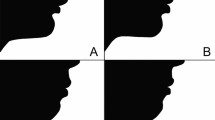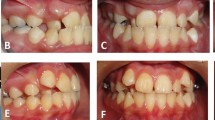Key Points
-
Describes the different types of functional appliance.
-
Explains the different ways in which functional appliances work.
-
Explores the evidence behind claims that functional appliances affect skeletal growth.
-
Outlines how functional appliances are used in orthodontic practice and their limitations.
Abstract
Functional appliances have been used for over 100 years in orthodontics to correct Class II malocclusion. During this time numerous different systems have been developed often accompanied by claims of modification and enhancement of growth. Recent clinical evidence has questioned whether they really have a lasting influence on facial growth, their skeletal effects appearing to be short term. However, despite these findings, the clinical effectiveness of these appliances is acknowledged and they can be very useful in the correction of sagittal arch discrepancies. This article will discuss the clinical use of functional appliances, the underlying evidence for their use and their limitations.
Similar content being viewed by others
Log in or create a free account to read this content
Gain free access to this article, as well as selected content from this journal and more on nature.com
or
References
Tulloch J F, Medland W, Tuncay O C . Methods used to evaluate growth modification in Class II malocclusion. Am J Orthod Dentofacial Orthop 1990: 98; 340–347.
Robin P . Observation sur un nouvel appareil de redressement. Rev Stomatol 1902; 9: 423.
Levrini A, Favero L . The masters of functional orthodontics. 1st ed. Milan: Quintessence, 2003.
Fränkel R . A functional approach to orofacial orthopaedics. Br J Orthod 1980: 7; 41–51.
Clark W J . The twin block technique. A functional orthopedic appliance system. Am J Orthod Dentofacial Orthop 1988; 93: 1–18.
Pancherz H . Treatment of Class II malocclusion by jumping the bite with the Herbst appliance. A cephalometric investigation. Am J Orthod 1979; 76: 423–442.
Mcnamara J A Jr . Neuromuscular and skeletal adaptations to altered function in the orofacial region. Am J Orthod 1973; 64: 578–606.
Voudouris J C, Woodside D G, Altuna G et al. Condyle-fossa modifications and muscle interactions during Herbst treatment, Part 2. Results and conclusions. Am J Orthod Dentofacial Orthop 2003; 124: 13–29.
Charlier J P, Petrovic A, Herrmann-Stutzmann J. Effects of mandibular hyperpropulsion on the prechondroblastic zone of young rat condyle. Am J Orthod 1969; 55: 71–74.
Mcnamara J A Jr, Hinton R J, Hoffman D L . Histologic analysis of temporomandibular joint adaptation to protrusive function in young adult rhesus monkeys (Macaca mulatta). Am J Orthod 1982; 82: 288–298.
Mcnamara J A Jr, Bryan F A Long-term mandibular adaptations to protrusive function: an experimental study in Macaca mulatta. Am J Orthod Dentofacial Orthop 1987; 92: 98–108.
Cozza P, Baccetti T, Franchi L, De Toffol L, McNamara J A Jr . Mandibular changes produced by functional appliances in Class II malocclusion: a systematic review. Am J Orthod Dentofacial Orthop 2005; 129: 599.e1–e12.
Keeling S D, Wheeler T T, King G J et al. Anteroposterior skeletal and dental changes in early Class II treatment with bionators and headgear. Am J Orthod Dentofacial Orthop 1998; 113: 40–50.
Tulloch J F, Phillips C, Koch G, Phillips C . The effect of early intervention on skeletal pattern in Class II malocclusion: a randomized clinical trial. Am J Orthod Dentofacial Orthop 1997; 111: 391–400.
O'Brien K, Wright J, Conboy F et al. Effectiveness of early orthodontic treatment with the Twin-block appliance: a multicentre, randomized, controlled trial. Part 1: Dental and skeletal effects. Am J Orthod Dentofacial Orthop 2003; 124: 234–243.
Tulloch J F, Proffit W R, Phillips C . Outcomes in a 2-phase randomized clinical trial of early Class II treatment. Am J Orthod Dentofacial Orthop 2004; 125: 657–667.
Dolce C, Mcgorray S P, Brazeau L et al. Timing of Class II treatment: skeletal changes comparing 1-phase and 2-phase treatment. Am J Orthod Dentofacial Orthop 2007; 132: 481–489.
O'Brien K, Wright J, Conboy F et al. Early treatment for Class II Division 1 malocclusion with Twin-block appliance: a multi-centre, randomized, controlled trial. Am J Orthod Dentofacial Orthop 2009; 135: 573–579.
Meikle M C What do prospective randomized clinical trials tell us about treatment of Class II malocclusions? A personal viewpoint. Eur J Orthod 2005; 27: 105–114.
Illing H M, Morris D O, Lee RT . A prospective evaluation of Bass, Bionator and Twin Block appliances. Part I-The hard tissues. Eur J Orthod 1998: 20: 501–516.
Gill D S, Lee R T . Prospective clinical trial comparing the effects of conventional Twin-block and mini-block appliances: Part 1. Hard tissue changes. Am J Orthod Dentofacial Orthop. 2005; 127: 465–472.
Lee R T, Kyi C S, Mack G J . A controlled clinical trial of the effects of the Twin Block and Dynamax appliances on the hard and soft tissues. Eur J Orthod 2007; 29: 272–282.
Lee R T, Barnes E, DiBiase A, Govender R, Qureshi U . An extended period of functional appliance therapy: a controlled clinical trial comparing the Twin Block and Dynamax appliances. Eur J Orthod 2014; 36: 512–521.
Johnston L E . If wishes were horses: functional appliances and growth modification. Prog Orthod 2005; 6: 36–47.
Thiruvenkatachari B, Harrison J E, Worthington H V, O'Brien K D . Orthodontic treatment for prominent upper front teeth (Class II malocclusion) in children. Cochrane Database Syst Rev 2013; 13: CD003452.
Baccetti T, Franchi L, Toth LR et al. Treatment timing for Twin-block therapy. Am J Orthod Dentofacial Orthop 2000; 118: 159–170.
O'Brien K, Wright J, Conboy F et al. Effectiveness of early orthodontic treatment with the Twin-block appliance: a multicentre, randomized, controlled trial. Part 2: Psychosocial effects. Am J Orthod Dentofacial Orthop 2003; 124: 488–494; discussion 494–495.
Banks P, Wright J, O'Brien K . Incremental versus maximum bite advancement during twin-block therapy: a randomized controlled clinical trial. Am J Orthod Dentofacial Orthop 2004; 126: 583–588.
Petit H P, Chateau M . The K Test and the Condylar Test. J Clin Orthod 1984; 18: 726–732.
O'Brien K, Wright J, Conboy F et al. Effectiveness of treatment for Class II malocclusion with the Herbst or Twin Block appliance: a randomized controlled trial. Am J Orthod Dentofacial Orthop 2003; 124: 128–137.
Author information
Authors and Affiliations
Corresponding author
Additional information
Refereed Paper
Rights and permissions
About this article
Cite this article
DiBiase, A., Cobourne, M. & Lee, R. The use of functional appliances in contemporary orthodontic practice. Br Dent J 218, 123–128 (2015). https://doi.org/10.1038/sj.bdj.2015.44
Accepted:
Published:
Issue date:
DOI: https://doi.org/10.1038/sj.bdj.2015.44
This article is cited by
-
Long-term (≥ 15 years) outcome quality after Class II:1 bionator or Herbst multibracket appliance treatment
Journal of Orofacial Orthopedics / Fortschritte der Kieferorthopädie (2024)
-
Differential skeletal and dental effects after orthodontic treatment with bite jumping appliance or activator: a retrospective cephalometric study
Clinical Oral Investigations (2020)



